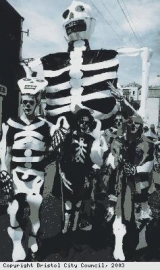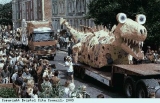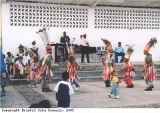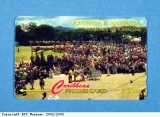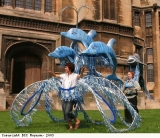Carnival
Many of Bristol’s African-Caribbean residents live in the St Pauls area of the city, which lends the Carnival its name. Bristol’s St Pauls Carnival is one of Britain’s largest after Notting Hill in London. The main event, a procession of colourful carnival floats and a day long music festival, takes place every July in St Pauls. The procession includes local organisations, schools and community groups who compete against each other for the winning place. After dark, when the procession is over, the sound systems take over. DJs battle it out in the streets with homemade amplifiers and P.A.s, which can be heard all over the city. Carnival attracts many thousands of people, of all colours and cultures. It is a huge celebration of African-Caribbean culture and is an important part of the city’s cultural identity.
Carnival itself may only last for one day, but the build-up spans many months. Workshops are run for schools and community groups based in and around the central area of Bristol. Local schoolchildren choreograph their dances and make their costumes. All year round, the Carnival organisers promote multi-racial music, theatre, film and sports events from their base at the Kuumba Centre in Hepburn Road, St Pauls.
Carnival can be traced back to the times of slavery in the Caribbean and in fact, even further to Africa. The enslaved Africans who worked on the plantations in the Caribbean created what we know today as Carnival. They took a mixture of European and African elements, and added their own influences from their new slave-culture. The enslaved Africans came from many different places in Africa. The slave owners mixed the slaves from different ethnic groups. The slaves could not communicate easily and did not share a common culture. This was perhaps done deliberately to avoid the slaves organising together against their owners. The slaves had little in common with each other, and had to almost start again in building a new culture. Some traditions were common to many African cultures, ‘masquerade ‘ was one such example. It is made up from three main elements: costume, music and dance.
Carnival began on plantations owned by Catholic Europeans, such as the Portuguese, Spanish and French. It is a celebration connected with the Catholic Church that takes place just before the start of the season of Lent. In Roman Catholic countries it marks the two days of feasting and festivities before Ash Wednesday and the fasting of Lent. Carnival, as we see it today practised by the African-Caribbean communities, is a fusion of the Catholic celebration and the African practice of masquerade.
European plantation owners allowed the Catholic practice of Carnival by the enslaved Africans. They encouraged their slaves to take an interest in their Roman Catholic religion, rather than their own African ones. By mixing Carnival with their own African tradition of masquerade, the enslaved Africans could celebrate their traditions under the disguise of a Catholic celebration. They could also make fun of their European masters using costumes, masks and dances. One example of this can be seen in the kind of dancing which the revellers perform. It combines African dancing and European ballroom dance steps, such as the ‘waltz’. The dancers mimic the European dance step, mocking the Europeans who had no more imagination than to create a simple ’1-2-3-4’ dance step that anybody could do! In times of slavery, it must have seemed amusing and strange to see the dancers dancing like this, with the men and women dancing in pairs like the Europeans do. In African dancing women and men often dance in separate groups in ritual performances. This sort of dance can be seen today in various cultures in Africa, such as the Yoruba people of Nigeria.
This fusion and re-making of African traditions with European ones, gives Carnival its unique Caribbean nature. The large main costume, crowned with a headdress, can be made with a great variety of materials. It sometimes includes symbolic items or colours representing certain beliefs. The traditional method of making such costumes in Africa includes using different kinds of natural objects such as bones, grasses, beads, shells and fabric. In different African cultures, each object or combination of objects represents a certain idea or spiritual force. The Carnival practise of parading through the streets is similar to African traditions of parading and moving in circles through villages in costumes and masks. Circling villages in this way is believed to bring good fortune, to heal problems, and appease angry relatives who had died and passed into the next world.
Carnival can be seen all over the world, wherever there are African-Caribbean communities. Carnival is enjoyed by all in Central and South America in Belize, Panama and Brazil, and in large cities in America, Canada and Britain where Caribbean people have settled, including London and Bristol.
